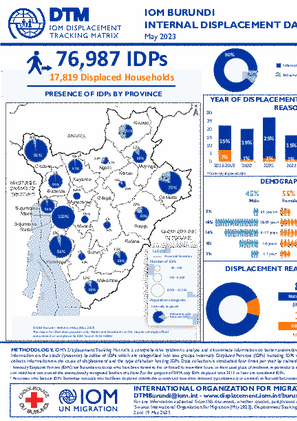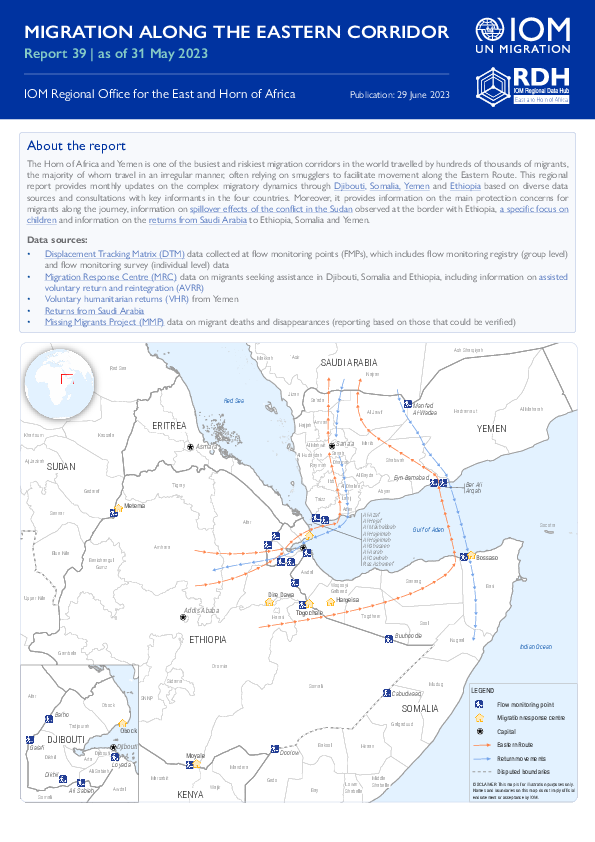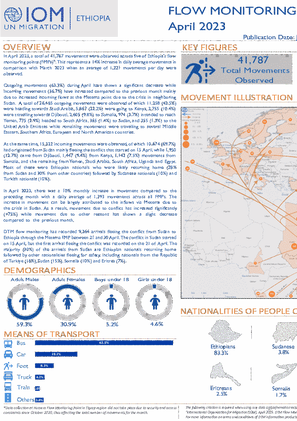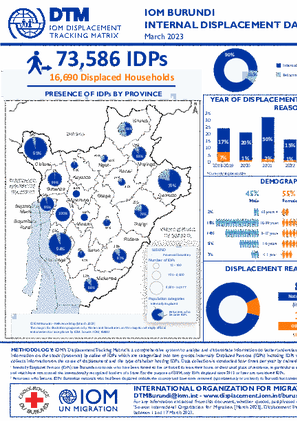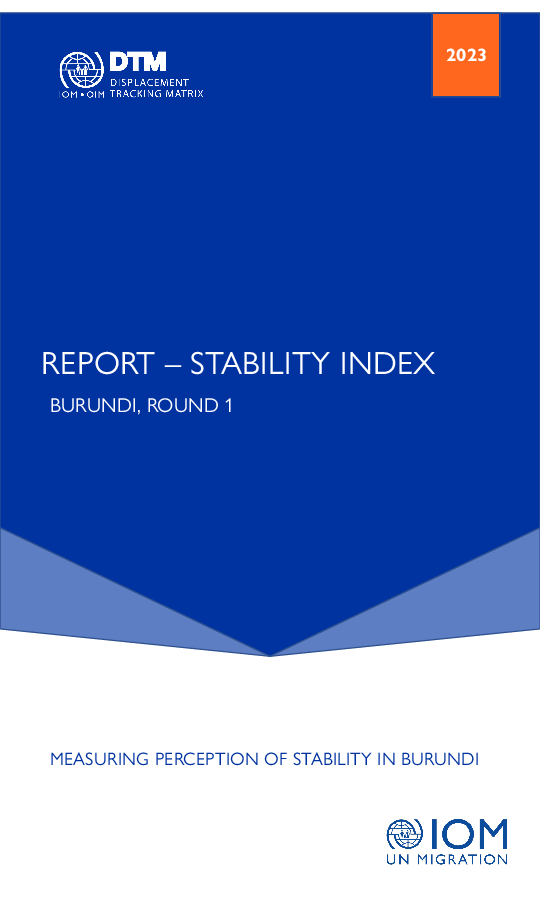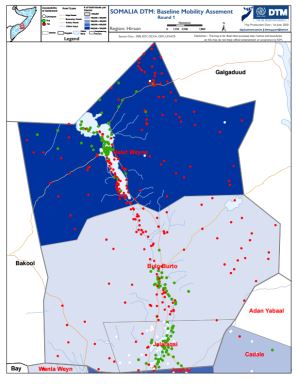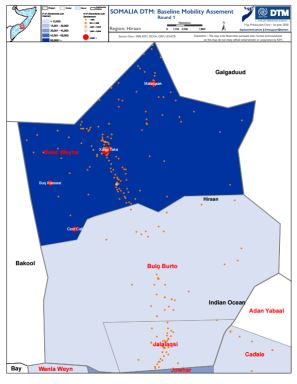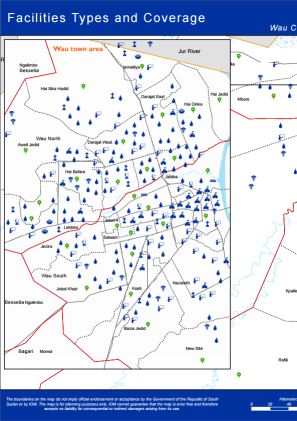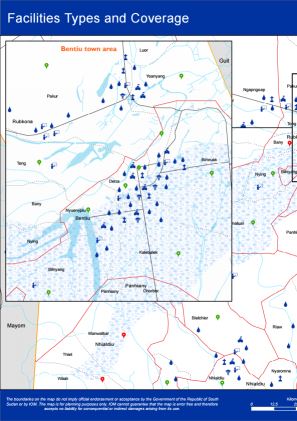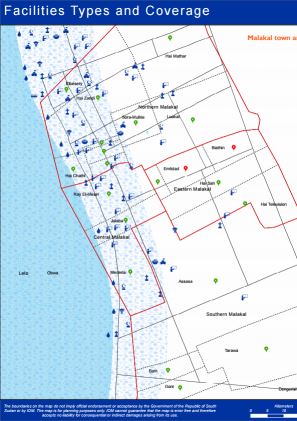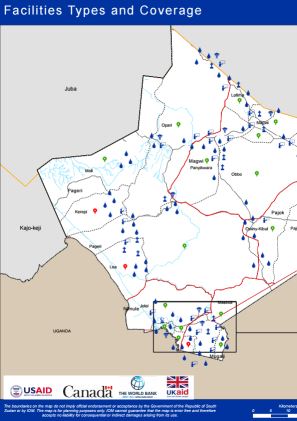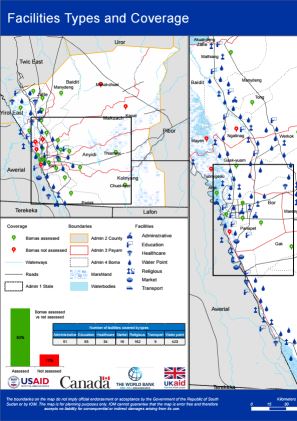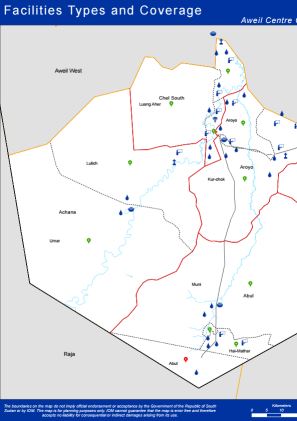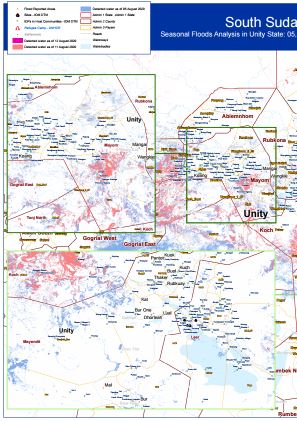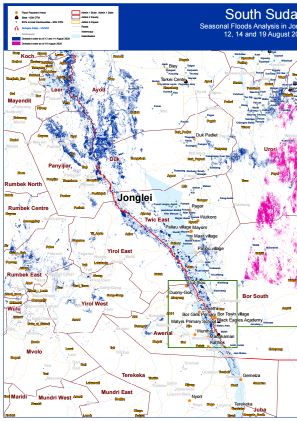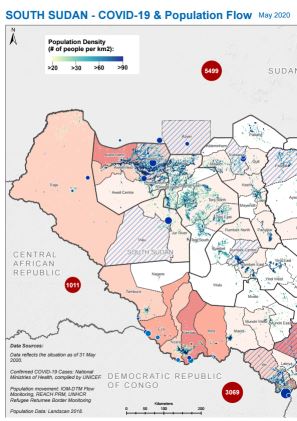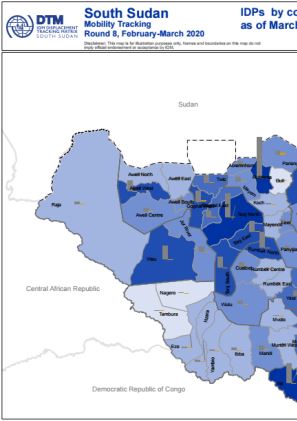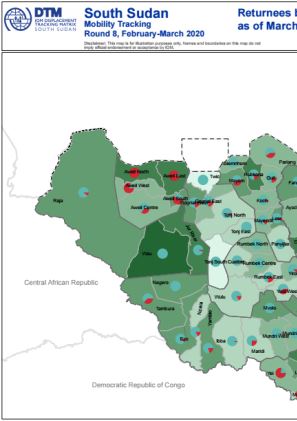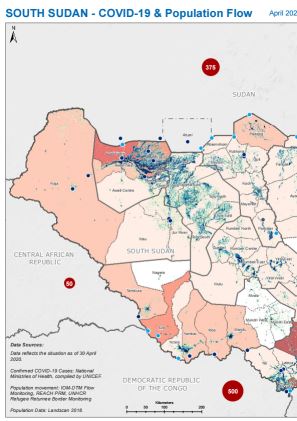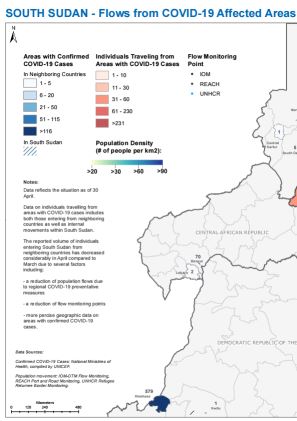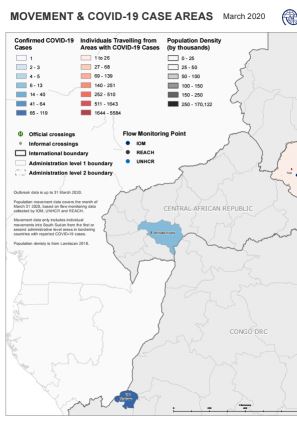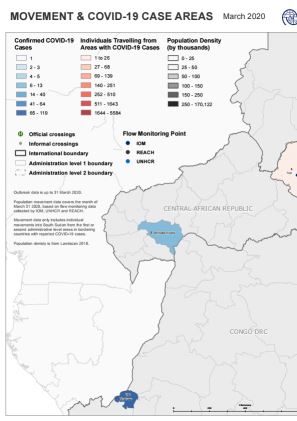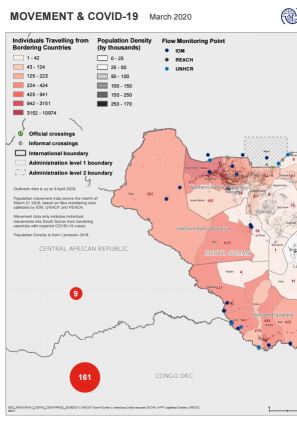-
Countries
-
Data and Analysis
-
Special Focus
-
Crisis Responses
East and the Horn of Africa
DTM East and the Horn of Africa
DTM Operations in the region
- Active DTM operation
- Past DTM operation
Burundi - Rapport d'évaluation des besoins multisectoriels – (Septembre 2022)
L'OIM a mis en oeuvre le premier MSNA au Burundi en août 2022, en collaboration avec le gouvernement du Burundi, le système de clusters et les agences internationales et nationales qui ont toutes contribué à façonner l'évaluation.
Jul 26 2023
Burundi - Rapport d'évaluation des besoins mu…
Migration Along the Eastern Corridor (June 2023)
The Horn of Africa and Yemen is one of the busiest and riskiest migration corridors in the world travelled by hundreds of thousands of migrants, the majority of whom travel in an irregular manner, often relying on smugglers to facilitate movement along the Eastern Route.
Jul 26 2023
Migration Along the Eastern Corridor (June 2023)
Burundi — Internal Displacement Dashboard (May 2023)
IOM’s Displacement Tracking Matrix is a comprehensive system to analyse and disseminate information to better understand the movements and needs of Internally Displaced Persons (IDPs) in Burundi.
Burundi — Tableau de bord des déplacements internes (Mai 2023)
La Matrice de Suivi des Déplacements de l’OIM est un système mis en œuvre dans le but de capturer, analyser et disséminer des informations pour mieux comprendre les mouvements et les besoins des personnes déplacées internes (PDI) au Burundi.
Ethiopia - Returned Migrants from Abroad, Amhara and Oromia regions (November 2022 - January 2023)
This snapshot report will present data on returned migrants from abroad collected by the International Organization for Migration (IOM) through its Displacement Tracking Matrix (DTM) methodology and Village Assessment Survey (VAS) tool in the Amhara and Oromia regions of Ethiopia between November
South Sudan — Mobility Tracking Round 13 Atlas (July - August 2022)
This atlas contains a summary of findings from the thirteenth round of Mobility Tracking conducted across South Sudan through key-informants based assessment at payam and location level between July and August 2022.
South Sudan — Mobility Tracking Round 12 Atlas (December 2021)
This atlas contains a summary of findings from the twelfth round of Mobility Tracking conducted across South Sudan through key-informants based assessment at payam and location level between as of December 2021.
Ethiopia — Climate Displacement Overview, Somali Region (July 2019 - December 2022)
This snapshot overview gathers and analyzes specific data records on displacement and returns related to drought and other climate-induced factors, such as floods, landslides and fire in Somali region of Ethiopia.
Ethiopia - National Climate Displacement Overview (July 2019 - January 2023)
The objective of this thematic report is to provide an overview of the International Organization for Migration (IOM)'s Data and Research Unit (DRU) data collected through its Displacement Tracking Matrix (DTM) methodology and Site Assessment (SA) and Village Assessment Surv
Uganda – Info Sheet: Multi-Hazard Response/DRR Platform (June 2023)
There was a notable reduction on the impacts, extent and intensity of disaster in the month of June. Floods were reported in Kasese, Bukedea and Kapelabyong. Heavy storms occurred in Namisindwa and Manafwa while landslides in Bududa.
Somalia — Border Point Flow Monitoring — (May 2023)
A total of 26,003 movements were observed in May 2023, representing 4 per cent decrease compared to February 2023 when 27,201 movements were observed during this period.
Djibouti — Rapport sur les points de suivi des flux (mai 2023)
En mai 2023, 22 556 mouvements migratoires ont été observés aux points de suivi des flux (FMP) à Djibouti soit une moyenne journalière de 728 mouvements migratoires.
Djibouti — Migration Trends Dashboard (May 2023)
In May 2023, 22,556 migratory movements were observed at flow monitoring points (FMPs) in Djibouti with a daily average of 728 migratory movements.
Jun 29 2023
Djibouti — Migration Trends Dashboard (May 2023)
Migration Along the Eastern Corridor (May 2023)
The Horn of Africa and Yemen is one of the busiest and riskiest migration corridors in the world travelled by hundreds of thousands of migrants, the majority of whom travel in an irregular manner, often relying on smugglers to facilitate movement along the Eastern Route.
Jun 29 2023
Migration Along the Eastern Corridor (May 2023)
Ethiopia — Shelter Snapshot Report (August – September 2022)
Between August and September 2022, the International Organization for Migration (IOM), through its Displacement Tracking Matrix (DTM) methodology, deployed the Site Assessment (SA) and Village Assessment Survey (VAS) tools to assess the mobility, needs and vulnerabilities of Internally Disp
Ethiopia — Flow Monitoring Dashboard 43 (April 2023)
In April 2023, a total of 41,787 movements were observed across five of Ethiopia's flow monitoring points (FMPs). This represents a 14% increase in daily average movements in comparison with March 2023 when an average of 1,221 movements per day were observed.
Burundi – Internal Displacement Trends (March 2023)
DTM has identified 73,586 internally displaced persons (IDPs) in 16,690 households. Almost all displacements were due to natural disasters (89%), while 11% were due to other reasons.
Somalia — Emergency Trend Tracking Round 66 — Gedo region — (Jun 03 — Jun 07, 2023)
There are 370,390 individuals currently displaced by drought in Gedo region. Since round 65 an estimated 3,726 IDPs arrived at the assessed settlements.
Burundi – Tableau de bord des déplacements internes (Mars 2023)
La DTM a identifié 73 586 personnes déplacées à l'intérieur du pays (PDI) dans 16 690 ménages. Presque tous les déplacements étaient dus à des catastrophes naturelles (89 %), tandis que 11 % étaient dus à d'autres raisons.
Somalia — Emergency Trend Tracking Round 65 — Gedo region — (May 27 — May 31, 2023)
There are 366,819 individuals currently displaced by drought in Gedo region. Since round 64 an estimated 4,077 IDPs arrived at the assessed settlements.
Ethiopia — National Displacement Report 15 (November 2022 - January 2023)
In order to capture the displacement and return dynamics in Ethiopia, DTM Ethiopia's National Displacement Report combines findings from its Site Assessment (SA) in Section 1 and findings from the Village Assessment Survey (VAS) in Section 2.
Burundi - Indice de Stabilité Round 1 (Mai 2023)
En mai 2020, le Burundi a organisé ses premières élections générales depuis 2015. Depuis l'inauguration du nouveau gouvernement en juin 2020, le pays a connu des améliorations notables en termes de sécurité et de situation politique et socio-économique.
Jun 08 2023
Burundi - Indice de Stabilité Round 1 (Mai 2023)
South Sudan — Inter Sectoral Needs Assessment Report- Rural Component (September 2022)
The overall objective of the 2022 humanitarian Inter-Sectoral Needs Assessment (ISNA) is to collect and analyze data on household needs and vulnerabilities, displacement and migration history, shelter and non-food items (SNFI), water, sanitation and hygiene (WASH), health, education, protection -
Burundi – Stability Index Round 1 (May 2023)
In May 2020, Burundi held its first general elections since 2015. Since the inauguration of the new government in June 2020, the country has seen significant improvements in security, political and socio-economic conditions.
Jun 08 2023
Burundi – Stability Index Round 1 (May 2023)
Pagination
South Sudan — COVID-19 Mobility Update Week 8 (11-17 May 2020)
May 26 2020
Dataset for COVID-19 Mobility Update 8
South Sudan — COVID-19 Mobility Update Week 7 (4-10 May 2020)
May 20 2020
Dataset for COVID-19 Mobility Update 7
South Sudan — Flow Monitoring Registry — March 2020
May 13 2020
Flow monitoring aims to derive quantitative estimates of the flow of individuals through specific locations and to collect information about the profile, intentions and vulnerabilities of the people moving. It aims to quantify highly mobile populations by providing a picture of complex mobility…
South Sudan — Flow Monitoring Registry — February 2020
May 13 2020
Flow monitoring aims to derive quantitative estimates of the flow of individuals through specific locations and to collect information about the profile, intentions and vulnerabilities of the people moving. It aims to quantify highly mobile populations by providing a picture of complex mobility…
South Sudan — COVID-19 Mobility Update Week 6 (27 April - 3 May 2020)
May 08 2020
Dataset for COVID-19 Mobility Update 6
Ethiopia - Site Assessment Round 21
May 07 2020
A site assessment is a sub-component of mobility tracking. It aims to collect data on population presence, living conditions and needs in a particular displacement site or community.
Ethiopia — Village Assessment Survey 4
May 07 2020
A village assessment survey (VAS) is a sub-component of mobility tracking. It collects data on returning IDPs, IDPs, returned migrants and host community members. VAS evaluates the absorption capacity of villages to receive returning IDPs with a focus on accessibility of services, livelihoods and…
South Sudan - Village Assessment Survey - Wau, Rubkona and Bor South, Boma Questionnaire (August - November 2019)
May 06 2020
Between August and November 2019, IOM’s Displacement Tracking Matrix (DTM) conducted Village Assessment Survey (VAS) in Rubkona, Wau and Bor South Counties assessing a total of 63 bomas (13 in Bor South, 11 in Rubkona and 39 in Wau) and carrying key informant interviews at 191 educational…
South Sudan - Village Assessment Survey - Wau, Rubkona and Bor South, Education (August - November 2019)
May 06 2020
Between August and November 2019, IOM’s Displacement Tracking Matrix (DTM) conducted Village Assessment Survey (VAS) in Rubkona, Wau and Bor South Counties assessing a total of 63 bomas (13 in Bor South, 11 in Rubkona and 39 in Wau) and carrying key informant interviews at 191 educational…
South Sudan - Village Assessment Survey - Wau, Rubkona and Bor South, Health (August - November 2019)
May 06 2020
Between August and November 2019, IOM’s Displacement Tracking Matrix (DTM) conducted Village Assessment Survey (VAS) in Rubkona, Wau and Bor South Counties assessing a total of 63 bomas (13 in Bor South, 11 in Rubkona and 39 in Wau) and carrying key informant interviews at 191 educational…
South Sudan - Village Assessment Survey - Wau, Rubkona and Bor South, FIS (August - November 2019)
May 06 2020
Between August and November 2019, IOM’s Displacement Tracking Matrix (DTM) conducted Village Assessment Survey (VAS) in Rubkona, Wau and Bor South Counties assessing a total of 63 bomas (13 in Bor South, 11 in Rubkona and 39 in Wau) and carrying key informant interviews at 191 educational…
Burundi — Baseline Assessment — Round 51
Apr 28 2020
A baseline assessment is a sub-component of mobility tracking. It aims to collect data on IDP, migrant or returnee population presence in a defined administrative area of the country.
Burundi — Données de Suivi des Urgences — 16 au 22 Mars 2020
Mar 24 2020
Activated on an ad hoc basis, the DTM Emergency Tracking provides early field reports at the beginning of a complex crisis, allowing IOM to gather, consolidate and disseminate baseline information on displacement and return figures at the onset of a newly emerging crisis. The DTM Emergency Tracking…
Burundi — Baseline Assessment — Round 50
Mar 18 2020
A baseline assessment is a sub-component of mobility tracking. It aims to collect data on IDP, migrant or returnee population presence in a defined administrative area of the country.
South Sudan — Flow Monitoring Registry — January 2020
Mar 17 2020
Flow monitoring aims to derive quantitative estimates of the flow of individuals through specific locations and to collect information about the profile, intentions and needs of the people moving and to quantify highly mobile populations by providing a picture of complex mobility dynamics.
Burundi — Données de Suivi des Urgences — 02 au 08 Mars 2020
Mar 10 2020
Activated on an ad hoc basis, the DTM Emergency Tracking provides early field reports at the beginning of a complex crisis, allowing IOM to gather, consolidate and disseminate baseline information on displacement and return figures at the onset of a newly emerging crisis. The DTM Emergency Tracking…
Burundi — Données de Suivi des Urgences — 24 Février - 01 Mars 2020
Mar 03 2020
Activated on an ad hoc basis, the DTM Emergency Tracking provides early field reports at the beginning of a complex crisis, allowing IOM to gather, consolidate and disseminate baseline information on displacement and return figures at the onset of a newly emerging crisis. The DTM Emergency Tracking…
Ethiopia — Village Assessment Survey 3
Feb 26 2020
A village assessment survey (VAS) is a sub-component of mobility tracking. It collects data on returning IDPs, IDPs, returned migrants and host community members. VAS evaluates the absorption capacity of villages to receive returning IDPs with a focus on accessibility of services, livelihoods and…
Pagination
South Sudan - Wau County_Village Assessment Survey_Facilities Infrastructure and Services
Since the beginning of the exercise in the last quarter of 2019, IOM’s Displacement Tracking Matrix (DTM) conducted Village Assessment Survey (VAS) across 7 counties covering 182 out of 219 bomas (achieving 83 per cent coverage) in Wau, Rubkona, Bor South, Torit, Magwi, Aweil Centre and Malakal counties. Additional 9 focus group discussions were conducted, due to varying perspectives on boma boundaries. To supplement the findings from the boma questionnaire, key informant interviews were conducted at 560 educational facilities and 150 health facilities. In addition to this, Facility, Infrastructure and Service mapping component geo referenced 3,227 facilities including administrative buildings, education facilities, healthcare facilities, markets, religious buildings, transport points and water points.
South Sudan - Torit County_Village Assessment Survey_Facilities Infrastructure and Services
Since the beginning of the exercise in the last quarter of 2019, IOM’s Displacement Tracking Matrix (DTM) conducted Village Assessment Survey (VAS) across 7 counties covering 182 out of 219 bomas (achieving 83 per cent coverage) in Wau, Rubkona, Bor South, Torit, Magwi, Aweil Centre and Malakal counties. Additional 9 focus group discussions were conducted, due to varying perspectives on boma boundaries. To supplement the findings from the boma questionnaire, key informant interviews were conducted at 560 educational facilities and 150 health facilities. In addition to this, Facility, Infrastructure and Service mapping component geo referenced 3,227 facilities including administrative buildings, education facilities, healthcare facilities, markets, religious buildings, transport points and water points.
South Sudan - Rubkona County_Village Assessment Survey_Facilities Infrastructure and Services
Since the beginning of the exercise in the last quarter of 2019, IOM’s Displacement Tracking Matrix (DTM) conducted Village Assessment Survey (VAS) across 7 counties covering 182 out of 219 bomas (achieving 83 per cent coverage) in Wau, Rubkona, Bor South, Torit, Magwi, Aweil Centre and Malakal counties. Additional 9 focus group discussions were conducted, due to varying perspectives on boma boundaries. To supplement the findings from the boma questionnaire, key informant interviews were conducted at 560 educational facilities and 150 health facilities. In addition to this, Facility, Infrastructure and Service mapping component geo referenced 3,227 facilities including administrative buildings, education facilities, healthcare facilities, markets, religious buildings, transport points and water points.
South Sudan - Malakal County_Village Assessment Survey_Facilities Infrastructure and Services
Since the beginning of the exercise in the last quarter of 2019, IOM’s Displacement Tracking Matrix (DTM) conducted Village Assessment Survey (VAS) across 7 counties covering 182 out of 219 bomas (achieving 83 per cent coverage) in Wau, Rubkona, Bor South, Torit, Magwi, Aweil Centre and Malakal counties. Additional 9 focus group discussions were conducted, due to varying perspectives on boma boundaries. To supplement the findings from the boma questionnaire, key informant interviews were conducted at 560 educational facilities and 150 health facilities. In addition to this, Facility, Infrastructure and Service mapping component geo referenced 3,227 facilities including administrative buildings, education facilities, healthcare facilities, markets, religious buildings, transport points and water points.
South Sudan - Magwi County_Village Assessment Survey_Facilities Infrastructure and Services
Since the beginning of the exercise in the last quarter of 2019, IOM’s Displacement Tracking Matrix (DTM) conducted Village Assessment Survey (VAS) across 7 counties covering 182 out of 219 bomas (achieving 83 per cent coverage) in Wau, Rubkona, Bor South, Torit, Magwi, Aweil Centre and Malakal counties. Additional 9 focus group discussions were conducted, due to varying perspectives on boma boundaries. To supplement the findings from the boma questionnaire, key informant interviews were conducted at 560 educational facilities and 150 health facilities. In addition to this, Facility, Infrastructure and Service mapping component geo referenced 3,227 facilities including administrative buildings, education facilities, healthcare facilities, markets, religious buildings, transport points and water points.
South Sudan - Bor South County_Village Assessment Survey_Facilities Infrastructure and Services
Since the beginning of the exercise in the last quarter of 2019, IOM’s Displacement Tracking Matrix (DTM) conducted Village Assessment Survey (VAS) across 7 counties covering 182 out of 219 bomas (achieving 83 per cent coverage) in Wau, Rubkona, Bor South, Torit, Magwi, Aweil Centre and Malakal counties. Additional 9 focus group discussions were conducted, due to varying perspectives on boma boundaries. To supplement the findings from the boma questionnaire, key informant interviews were conducted at 560 educational facilities and 150 health facilities. In addition to this, Facility, Infrastructure and Service mapping component geo referenced 3,227 facilities including administrative buildings, education facilities, healthcare facilities, markets, religious buildings, transport points and water points.
South Sudan - Aweil Centre County_Village Assessment Survey_Facilities Infrastructure and Services
Since the beginning of the exercise in the last quarter of 2019, IOM’s Displacement Tracking Matrix (DTM) conducted Village Assessment Survey (VAS) across 7 counties covering 182 out of 219 bomas (achieving 83 per cent coverage) in Wau, Rubkona, Bor South, Torit, Magwi, Aweil Centre and Malakal counties. Additional 9 focus group discussions were conducted, due to varying perspectives on boma boundaries. To supplement the findings from the boma questionnaire, key informant interviews were conducted at 560 educational facilities and 150 health facilities. In addition to this, Facility, Infrastructure and Service mapping component geo referenced 3,227 facilities including administrative buildings, education facilities, healthcare facilities, markets, religious buildings, transport points and water points.
South Sudan — Unity State Flooding (August 2020)
Seasonal Floods Analysis in Unity State for 5, 11 and 12 August 2020
South Sudan — Jonglei State Flooding (August 2020)
Seasonal Floods Analysis in Jonglei State for12, 14 and 19 August 2020
South Sudan — COVID-19 — Inflows from neighbouring countries (May 2020)
IOM DTM, UNHCR and REACH combined their flow monitoring data for South Sudan with geographically disaggregated data about COVID-19 cases in South Sudan and neighbouring countries compiled by UNICEF, with the aim of mapping population inflows at risk of COVID-19 transmission. This map shows the total number of incoming individual movements recorded across all flow monitoring points.Data reflects the situation as of 31 May.
South Sudan — COVID-19 — Flows From Affected Areas (May 2020)
IOM DTM, UNHCR and REACH combined their flow monitoring data for South Sudan with geographically disaggreagated data about COVID-19 cases in South Sudan and neighbouring countries compiled by UNICEF, with the aim of mapping population flows that may be vulnerable to COVID-19 transmission. Data on individuals travelling from areas with COVID-19 cases includes both those entering from neighbouring countries as well as internal movements within South Sudan.The data reflects the situation as of 31 May
South Sudan — Mobility Tracking Round 8 IDPs by County (March 2020)
This map displays the number of IDPs by county as of March 2020 (round 8 of mobility tracking).
South Sudan — Mobility Tracking Round 8 Returnees by County (March 2020)
This map displays the number of returnees by county as of March 2020 (round 8 of mobility tracking).
South Sudan — COVID-19 - Inflows Flow Neighbouring Countries (April 2020)
IOM DTM, UNHCR and REACH combined their flow monitoring data for South Sudan with geographically disaggregated data about COVID-19 cases in neighbouring countries compiled by UNICEF, with the aim of mapping population inflows at risk of COVID-19 transmission. Data on individuals travelling from areas with COVID-19 cases includes both those entering from neighbouring countries as well as internal movements within South Sudan. The reported volume of individuals entering South Sudan from neighbouring countries has decreased considerably in April compared to March due to several factors:a reduction of population flows due to regional COVID-19 preventive measuresa reduction of flow monitoring pointsmore precise geographic data on areas with confirmed COVID-19 casesData reflects the situation as of 30 April.
South Sudan — COVID-19 - Inflows From Affected Areas in Neighbouring Countries (April 2020)
IOM DTM, UNHCR and REACH combined their flow monitoring data for South Sudan with geographically disaggreagated data about COVID-19 cases in neighbouring countries compiled by UNICEF, with the aim of mapping population inflows at risk of COVID-19 transmission. Data on individuals travelling from areas with COVID-19 cases includes both those entering from neighbouring countries as well as internal movements within South Sudan. The reported volume of individuals entering South Sudan from neighboring countries has decreased considerably in April compared to March due to several factors:a reduction of population flows due to regional COVID-19 preventative measuresa reduction of flow monitoring pointsmore precise geographic data on areas with confirmed COVID-19 casesData reflects the situation as of 30 April.
South Sudan — COVID-19 — Inflows From Affected Areas in Neighbouring Countries (March 2020)
IOM DTM, UNHCR and REACH combined their flow monitoring data for South Sudan with geographically disaggregated data about COVID-19 cases in neighbouring countries compiled by UNICEF, with the aim of mapping population inflows at risk of COVID-19 transmission. The analysis is indicative of incoming movements 73 flow monitoring points at South Sudan’s borders and internal transport hubs, of which 65 recorded incoming cross-border travel in March 2020. This map shows inflows from COVID-19 affected areas in neighbouring countries in March 2020. COVID-19 cases in neighbouring countries are mapped at the first administrative level in Kenya, the Democratic Republic of Congo and the Central African Republic, and at the second administrative level in Uganda, Sudan and Ethiopia.
South Sudan — COVID-19 — Inflows From Affected Areas in Neighbouring Countries (March 2020)
IOM DTM, UNHCR and REACH combined their flow monitoring data for South Sudan with geographically disaggregated data about COVID-19 cases in neighbouring countries compiled by UNICEF, with the aim of mapping population inflows at risk of COVID-19 transmission. The analysis is indicative of incoming movements 73 flow monitoring points at South Sudan’s borders and internal transport hubs, of which 65 recorded incoming cross-border travel in March 2020. This map shows inflows from affected areas in neighbouring countries in March 2020. Cases are mapped at the first administrative level for Kenya, the Central African Republic and the Democratic Republic of Congo, and at the second administrative level for Ethiopia, Uganda and Sudan.
South Sudan — COVID-19 — Inflows from neighbouring countries (March 2020)
IOM DTM, UNHCR and REACH combined their flow monitoring data for South Sudan with geographically disaggregated data about COVID-19 cases in neighbouring countries compiled by UNICEF, with the aim of mapping population inflows at risk of COVID-19 transmission. The analysis is indicative of incoming movements 73 flow monitoring points at South Sudan’s borders and internal transport hubs, of which 65 recorded incoming cross-border travel in March 2020. This map shows overall inflows from neighbouring countries in March 2020.


